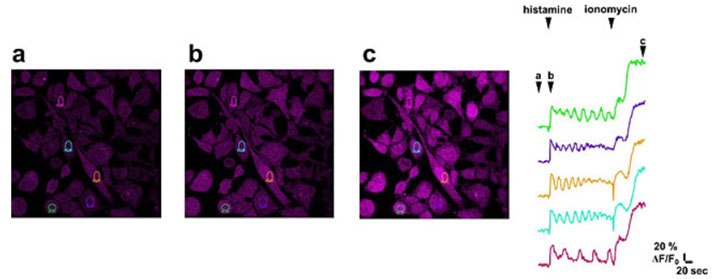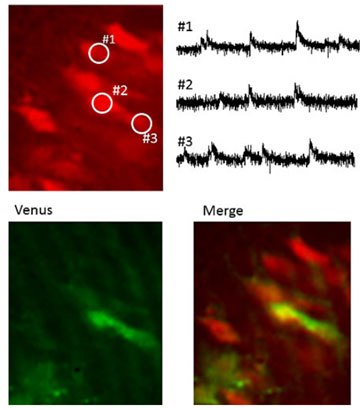Live Cell Calcium Indicators
Fluorescent Dyes for Calcium Imaging Experiments
Calcium ions (Ca2+) play vital cellular physiology roles in signal transduction pathways, in neurotransmitter release, in contraction of all muscle cell types, as enzyme cofactors, and in fertilization. Extracellular calcium is also important for maintaining the potential difference across excitable cell membranes, as is well known as a requirement for proper bone formation. Analyzing calcium flux using live cell calcium imaging techniques is important to understanding cellular function and dysfunctions that may be components of disease.
Chemical calcium indicators and sensors are small molecules that bind calcium ions via chelation. Many are based on widely-used calcium chelators like EGTA, (ethylene glycol-bis(β-aminoethyl ether), or on chelators with enhanced calcium ion (Ca2+)specificity or pH stability, such as BAPTA (1,2-bis(o-aminophenoxy)ethane-N,N,N′,N′-tetraacetic acid). These dyes are often modified with acetoxymethyl esters (AM), in order to render the molecule lipophilic and to allow easy entrance into the cell. Once inside the cell, cellular esterases will free the carboxyl groups,enabling Ca2+ by the indicator. Binding of a Ca2+ ion to a fluorescent indicator molecule leads either to an increase in quantum yield of fluorescence or an emission/excitation wavelength shift.
Traditional and Novel Calcium Imaging Probes
Fura-2: A UV light-excitable, ratiometric Ca2+ indicator that is a common dye for ratio-imaging microscopy. Upon binding Ca2+, Fura-2 exhibits an absorption shift that can be observed by scanning the excitation spectrum between 300 and 400 nm, while monitoring the emission at ~510 nm.
Indo-1: A UV light-excitable Ca2+ indicator that is the preferred calcium sensor for flow cytometry that uses a single laser for excitation. The emission maximum of Indo-1 shifts from ~475 nm in Ca2+-free medium to ~400 nm when the dye is saturated with Ca2+.
Quin-2: Displays high selectivity for calcium. This calcium indicator is not affected by sodium gradients, membrane potential range, or intracellular pH, and displays high affinity for Ca2+ ions .Quin-2 is sensitive enough to monitor low levels of calcium, such as those found in resting cells. Excitation and emission maxima are 339/492 nm, respectively.
Fluo-3: A fluorescence indicator of intracellular calcium (Ca2+) used in flow cytometry and confocal laser scanning microscopy. Upon binding of Ca2+, its fluorescence increases sharply with an emission maximum at 525nm and is suitable for detection using a fluorescein isothiocyanate (FITC) channel.
Near-Infrared Calcium Dyes: BioTracker NIR Ca2+ dyes (SCT021, SCT022, SCT023) are far-red fluorescent calcium indicators. These dyes changes fluorescent intensity greatly (1000-fold) when it binds to calcium in living cells. The advantage of these long wavelength dyes is greater tissue penetration, lower phototoxicity along with multicolor imaging using Hoechst, Fluorescein, Rhodamine, GFP, YFP and RFP etc.

Figure 1. Imaging of calcium flux in cancer cells. BioTracker 609 Red Ca2+ AM Dye (SCT021) loaded HeLa cells (A) were stimulated with 1 μM of histamine (B) to induce calcium oscillation. 3 minutes later, the cells were also stimulated with 5 μM of ionomycin (C) to induce calcium influx to the cytoplasm.

Figure 2. Imaging of calcium flux in mouse cranial nerves. BioTracker 664 NIR Ca2+ AM Dye (SCT023) was added to a mouse brain slice in which a fraction of neurons expressed Venus (a mutant of YFP) and live Ca2+ imaging was analyzed. Ca2+ is shown as red color and Venus is shown green. Fluorescent signal is was visualized as transient elevation of intracellular Ca2+ concentration associated with Ca2+ spark of cranial nerves. Due to its near-infared fluorescence, various multicolor imaging is possible including GFP reporters and other green live cell dyes.
Ordering Information
To continue reading please sign in or create an account.
Don't Have An Account?